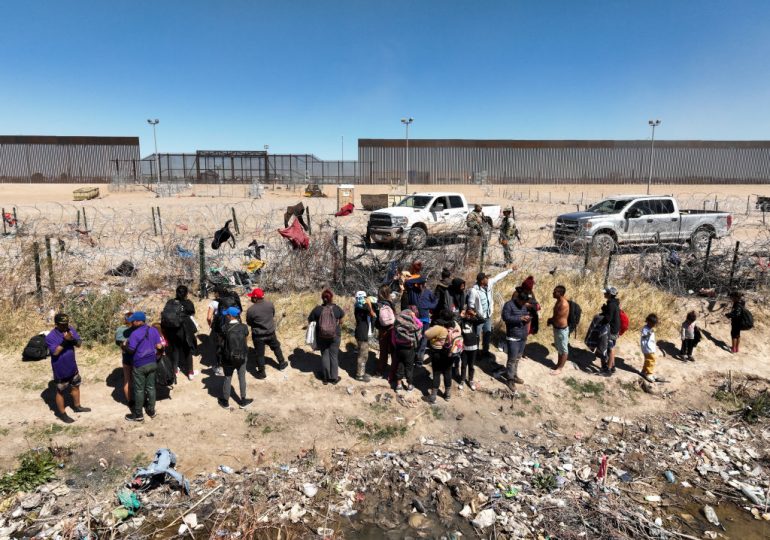A piece of the economic puzzle fell into place when new immigration estimates emerged from the Congressional Budget Office.
[time-brightcove not-tgx=”true”]
“The numbers are actually higher, and that actually explains what we’ve been asking ourselves,” Federal Reserve Chairman Jerome Powell said on Wednesday, “which is, ‘How can the economy have grown over 3 percent in a year where almost every outside economist was forecasting a recession?’”
The U.S. economy has made a strikingly strong comeback from the pandemic. Recession fears retreated as economic indicators exceeded expectations again and again. In fact, some indicators have come in seemingly too strong. Employment growth has been red hot, ostensibly too fast for low and stable inflation. Consumer spending has been bafflingly high. These indicators have prompted handwringing from economists, including those at the Federal Reserve who are working to slow inflation.
The increase in immigration estimated by CBO helps to explain this unusual economic recovery and means the labor market may not need to slow much to bring down inflation.
In 2019, the CBO projected that net immigration in 2023 would total 1.0 million people. Now, the agency estimates that net immigration last year was 3.3 million. That means the population and the labor force have grown faster than statistical agencies and economists like us believed.
With more people entering the workforce, employment can grow faster than we thought. When employment grows faster than the labor market can accommodate, it can drive up wages and prices, fueling inflation. We saw this as consumer demand recovered coming out of the pandemic: When businesses struggled to hire employees and meet consumer demand, many raised wages and prices.
Under prior assumptions about the labor market, employment could have grown by 60,000 to 130,000 per month last year without putting pressure on inflation. Employment growth in 2023 turned out to be two to four times that pace—an average of about 255,000 per month—according to the Bureau of Labor Statistics.
But, when we account for the higher immigration numbers, our analysis pins last year’s sustainable monthly employment growth to 160,000 to 230,000—still less than the actual employment growth, but far less so than previously thought.
Now that we know that the labor force was much larger due to the increased immigration, we are no longer so concerned about employment growth running too hot and pushing up prices. For those keeping an eye on the monthly employment reports, we calculate that if strong immigration continues this year, employment growth of nearly 200,000 workers a month is consistent with a healthy labor market. That number is nearly double what would have been sustainable without the pickup in immigration.
Increased immigration numbers help to explain other aspects of the recovery, too. A larger population means that there are more people to make and spend money. In fact, we directly attribute $46 billion of last year’s real consumer spending (in inflation-adjusted 2017 dollars to be consistent with statistics from the Bureau of Economic Analysis) to the recent increase in immigration.
The economic activity directly generated by increased immigration boosted real GDP growth by 0.1 percentage point in 2022 and 2023, according to our calculations. This year, we expect that continued strong immigration will boost real consumer spending growth by 0.2 percentage points and real GDP growth by 0.1 percentage point.
It is possible that the increased consumer demand raised prices and wages in particular sectors. Overall, though, we see little additional pressure on aggregate inflation because the increased immigration also generated greater production. In other words, the increase in productive capacity helped to counteract inflationary pressures that would arise from more people living in the U.S.
The new immigration estimates are a relief—to us and, we imagine, to the Federal Reserve. The extra economic capacity helps make sense of those too-strong economic indicators. In particular, the Fed does not need to slow the labor market as much to keep inflation under control.
The U.S. economy will need immigration in the long term too if it is to keep growing. Our aging population and declining birth rates mean a shrinking labor force. Moreover, with fewer young workers and more Social Security and Medicaid recipients, the federal budget comes under pressure.
Immigration helps address our long-run fiscal challenge. A National Academies report looked at immigrants who arrived between 2006 and 2013 and projects that over 75 years, each will contribute an average of $330,000 more in taxes than they and their descendants will receive in benefits. Immigration brings other long-term economic benefits too, including innovation and a boost to the productivity of native-born workers.
Despite these benefits, we recognize that an influx of immigrants has stressed the current budgets of some states and localities. We propose a method to transfer some of the federal gains from immigration to the communities that bear the near-term costs, which would help alleviate pressure on resources.
Indeed, we will need thoughtful policy to sustain the economic benefits of immigration. Many of the regular employment and family-based immigration pathways are capped at levels set in 1990, when the U.S. economy was half its current size. And for those without higher education or a close relative in the U.S., there is typically no route to lawful entry other than seeking asylum at the U.S. border. The strong U.S. economy coupled with upheaval in many parts of the world has created an impetus for millions to do just that.
To be sure, the capacity at the border is inadequate to meet the demands of the current situation. But, policymakers could jeopardize recent economic gains with excessive restrictions on border flows, particularly if not paired with expanded opportunities for regular migration.
Decades of research have shown the value in significantly expanding immigration. To maximize the economic benefits, Congress will need to create more pathways for legal immigration, reimagine the enforcement system, and support communities that welcome large numbers of immigrants.
It’s well past time for Congress to act on immigration. There are humanitarian reasons to welcome migrants from nations in crises, and the past few years have proven that there are also economic reasons. In future years, the vitality of the U.S. population and economy will hinge on immigration policy decisions made now.
Leave a comment







